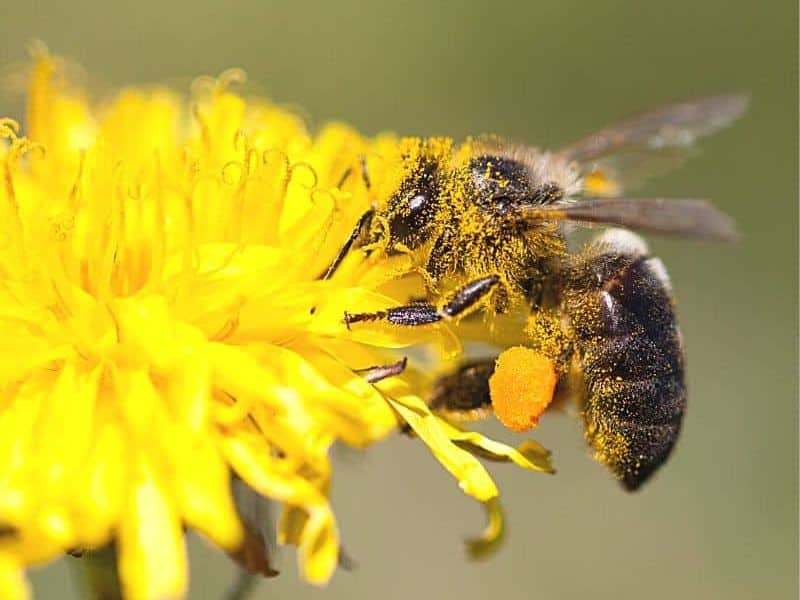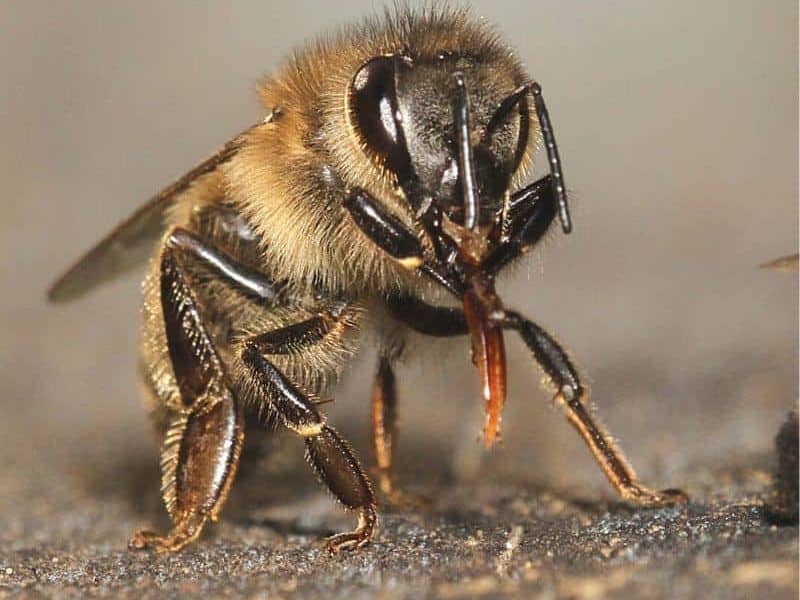Carniolan Honey Bees
In the world of beekeeping, there exists a remarkable bee that is a strong favorite among many beekeepers – the Carniolan honey bee. Perhaps you think all honey bees are just the same? Brace yourself for a sweet truth – there is much diversity in the honey bee family. How can you possibly choose the best ones for your hive? You have to do your research to see if Carniolan bees many have the characteristics that you desire for your hives.

Carniolans are a distinct race of the European honey bee family. In fact, Carniolans are the second most popular type of honey bee – ranking just below Italians (Apis mellifera ligustica).
“Carnis” – The Honey Bee of the Alps
Often called “carnis” for short – Carniolans are a subspecies of the European honey bee – or “Wester Honey bees”.
This is to differentiate them from their distant cousins Apis cerana found in Asia. The name is pronounced with the emphasis on the first syllable- Car-ni-olan.
Appearance
They are relatively the same size as other honey bees. The dark body has brown bands covered with short hairs of a grayish tint. This gives them the nickname “grey bee”.
In a hive, you would have trouble identifying Carniolan bees if the other hive members were also dark.

Place of Origin
One of the most popular honey bees in the world, Carniolans (Apis mellifera carnica) originated in parts of Eastern Europe.
The Carniola region of Slovenia, parts of the Austrian Alps and the North Balkans were their home. You may hear them referred to as the “honey bee of the alps”.
Bees that develop in certain regions must adapt to the conditions of the area. Those that do not adapt to the temperatures or nectar availability die out.
Of course, this process takes hundreds (or thousands) of years. But eventually, the survivors will be insects that thrive in their native region or other areas with similar conditions.
Due to the climate conditions where Carniolans developed, they are well-adapted to areas with long hot summers and long cold Winters. This makes them a good fit for many parts of the United States.
Coming to America
Carniolan bees were introduced into North America in the mid-late 1800’s. Today, we have Carniolan strains (mixed genetics) through-out the stock of bees in America.
They are also a popular race of honey bee to use in bee breeding programs such as the New World Carniolan project. They have some qualities that researchers want to develop in the current gene pool.

Behavioral Characteristics of Carniolan Honey Bees
Carniolan bees have some impressive characteristics that make them a beekeeper favorite.
- rapid buildup in the Spring beehive
- match brood rearing to conditions
- calm manner
- over-winters well in cold climates
- produces less propolis
- longer tongues to access flowers
- good sense of orientation – less drifting bees
Rapid Buildup of Population
After over-wintering as a smaller cluster, brood rearing ramps up quickly when fresh nectar and pollen is available. This is a valuable trait if you live in a region where the major nectar flow comes early in the year. You need a work force ready to respond.
Matches Brood Rearing to Forage Availability
Likewise, if food resources become scarce (perhaps a nectar dearth) – brood rearing is reduced quickly. A Carni queen will suspend egg laying until food availability picks up. This helps prevent colony starvation during a short term drought or similar conditions.
Calm Temperament
Carniolans have a reputation for being a calmer bee. They are less defensive than some races and less prone to stinging without provocation.
Though any colony has the capacity to defend themselves and will do so. It is the responsibility of the beekeeper to learn how to effectively manage their hives.
Over-Winters Well
If you live in an area that has cold, damp Winters, having some Carniolan genetics in your apiary is a good practice. They originate in regions that experience cold temperatures for months at a time. Most of our colonies are a mix of bee genetics and not all fair as well in all climates.
Less Propolis
Propolis or “bee glue” is an important part of hive life. However, it can be a pain to beekeepers during hive inspections.
Some colonies produce so much of it that colony inspections are made very difficult. If you fail to assemble your hive frames with a good amount of glue, you know the angst of having them come apart at the worse possible time. Carniolan bees tend to produce less propolis than others making inspections easier.
Long Tongues More Flowers
Here is a difference in the anatomy of this honey bee. Having a longer tongue that other honey bees, Carniolan bees are able to reach more nectar in deep throated flowers.
This can be a definite advantage if the honey plants in your area are tube shaped. This is the case for some types of clovers.
Good Orientation
Carniolans possess a good sense of direction or orientation. Beekeepers know that sometimes forager bees return to the wrong hive. They may be welcomed in-if they are have a good load of food on board.
But, beekeepers call this “drifting” and it is not the best situation. Some hives become too strong and others lose needed workers.
This is one reason we paint or decorate our hives with special designs or colors. But, it seems that Carnis do a better job than Italians of finding their own front door.

Why Beekeepers Like Carniolans: Pros and Cons
Several of the characteristics of the Carniolan bee are responsible for making them a good choice for your apiary. However, as with any race of bees, we must look at the pros and cons.
Pros
- respond quickly to changes in food sources -brood production
- as gentle as Italians
- good honey production
- fly at cooler temperatures
- less prone to hive robbing
- thrifty with stored honey reserves during winter
- some resistance to tracheal mites
- “may be” less susceptible to brood diseases
Colonies that adjust the amount of brood rearing to food supply are less likely to need beekeeper intervention.
Feeding bees sugar water is a useful technique but their own honey and pollen is always the first choice.
Carniolan queens tend to continue brood rearing until late September making for strong colonies going into Winter.
Not many people I know enjoy bee stings. Beekeepers understand why bees sting and work to avoid it.
However, if you are keeping bees in the backyard or a neighborhood – having good tempered colonies is a plus.
Because of their native region, Carniolan honey bees fly at cooler temperatures and damper conditions on overcast days than some types.
This may help them be good honey producers -even when weather conditions are not ideal.
Robbing bees can be a big problem in a bee yard where many hives are close together. Carnis are not quite as “grabby” as their Italian cousins.
By the same token, they are also very thrifty with their Winter food stores. In addition to adjusting the colony population to the season, they do not need as much food for the Winter months.
Carniolans are over-all a healthy bee. They do show some resistance to tracheal mites and perhaps to some brood diseases.
However, they require maintenance and varroa monitoring and control just like any other colonies.
Cons
Even these wonderful bees are not without some minuses that need to be considered.
- swarming tendencies
- frequent inspections during Spring buildup
- may not be ready for early honey flows
When plant nectar becomes readily available in Spring, Carniolan bees will ramp up brood rearing at an alarming rate. This can cause unwanted bee swarms for beekeepers that do not keep on top of things.
Due to the rapid rate of expansion, hive inspections may be needed more frequently during Spring. Boxes should be added to the hive at the right time to avoid over-crowding.
The honey flow (or honey flows) differ for each part of the country. If you only have one major honey flow (like me) that occurs in early Spring – your colonies may not be ready.
We rely on good weather to allow bees to forage on Red Maple and other early food sources. This gives them an opportunity to rear brood for the major flow.
A very cold or wet late Winter/early Spring can result in slow buildup unless the beekeeper feeds the hive. Monitoring colony conditions on warm days becomes very important in these situations.
Differences between Italian Bees and Carniolans
Due to their close kinship, you will find many ways in these bees are alike. That’s a great thing because it means that either will likely do well in your hive.
It is one reason, many suppliers intentionally cross them – hoping to get the best of both worlds. But, here are some generalities that are noticeable between the pure strains.
- Italians are the most popular race of bee in the United States
- A hive of Italians will start brood production earlier than Carniolans
- Carniolans – quicker to ramp up or reduce brood rearing as food availability changes
- Italian queens reduce brood rearing earlier in the Fall
- Carniolans have a higher tendency towards swarming
- Both races are relatively gentle and able to be managed
- Carniolans defend the hive against insects a bit more than Italians –hornets, yellow jackets etc.

Finding pure Carniolan honey bees in the U.S. is just about impossible. Most commercially available package bees or nucs are a mix of genetics – regardless of what the ads say.
Still, you can buy honey bees that are an Italian Carni mix. And, you can find some great Carni mix queens to introduce some new genetics to your existing hives.
Bee breeders – through artificial insemination produce breeder queens of a pure nature. But, those are hundreds of dollars and out of reach of the average hobby beekeeper.
Keep in mind that there is no perfect honey bee. When we say that a kind of bee is this or that – it is just a generalization.
The Italian honey bee has a reputation for being calm and non-defensive. But, I have had them chase me across the field before. Each hive is different – no matter the genetic ancestry of the inhabitants.
FAQ
Italians and Carniolans are different races of the same species – Apis mellifera. The queens and drones of each are able to inter-mate.
Yes, it is normally a simple matter to introduce a Carniolan queen bee into another colony. Always use proper introduction techniques when requeening a hive.
Not necessarily, both Carniolan and Italian bees share some desirable characteristics that make them good for new beekeepers.
These honey bees tend to have a gentle disposition. Carniolan bees are not as aggressive as some types but will sting in defense.
Yes, in fact – Carniolans may produce more honey than some others due to their tendency to forager on cooler days.
Final Thoughts
Without a doubt, Carniolan bees have some very desirable characteristics that make them a nice addition to any apiary. Find a reputable breeder and considering adding some those these genetics to your bee yard.

